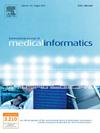Exploring Multimorbidity Patterns in older hospitalized Norwegian patients using Network Analysis modularity
IF 3.7
2区 医学
Q2 COMPUTER SCIENCE, INFORMATION SYSTEMS
International Journal of Medical Informatics
Pub Date : 2025-04-26
DOI:10.1016/j.ijmedinf.2025.105954
引用次数: 0
Abstract
Background
Understanding Multimorbidity Patterns (MPs) is crucial for planning healthcare interventions, allocating resources, and improving patients’ outcomes.
Objective
We aim to demonstrate the use of Network Analysis (NA) to explore the MPs in hospitalized Norwegian older patients.
Methods
We utilized data from the Norwegian Patient Registry (NPR) of all admissions between 2017 and 2019. The study population included patients ≥ 65 years old with two or more different conditions. Multimorbidity was defined as the co-occurrence of two or more associated chronic conditions. Chronic conditions were identified using the Chronic Condition Indicator Refined (CCIR) list. The association between chronic conditions was determined by calculating Relative Risk (RR) and Phi-correlation to detect pairs of conditions that co-occur beyond chance. A multimorbidity network was created, and MPs were detected using Louvain method for community detection. We suggested a clinical interpretation for these MPs.
Results
A total of 539 chronic conditions were used to create a multimorbidity network revealing several MPs. These modules included patterns of vision and hearing disorders, cardiorenal syndrome, metabolic and cardiovascular disorders, respiratory disorders, endocrine and skin conditions, autoimmune and musculoskeletal disorders, as well as mental and behavioral disorders. Using NA centrality measures, we identified the most influential conditions in each module. An interactive network and sunburst graphs for each module are publicly available.
Conclusion
The study demonstrates the use of NA modularity detection in identifying MPs. The findings highlight the complex interaction of chronic conditions in the elderly and the potential of NA methodology in exploring these relationships.
使用网络分析模块探索挪威住院老年患者的多病模式
背景了解多病模式(MPs)对于规划医疗干预、分配资源和改善患者预后至关重要。目的利用网络分析(NA)探讨挪威住院老年患者的MPs。方法:我们利用挪威患者登记处(NPR) 2017年至2019年所有入院患者的数据。研究人群包括年龄≥65岁且有两种或两种以上不同疾病的患者。多病被定义为两种或两种以上相关慢性疾病的共同发生。使用慢性疾病指标精炼(CCIR)列表确定慢性疾病。通过计算相对风险(RR)和phi相关来确定慢性病之间的关联,以检测非偶然同时发生的成对疾病。建立多病网络,采用Louvain方法对MPs进行社区检测。我们建议对这些MPs进行临床解释。结果共使用539种慢性疾病建立了一个揭示几种MPs的多病症网络。这些模块包括视力和听力障碍、心肾综合征、代谢和心血管疾病、呼吸系统疾病、内分泌和皮肤疾病、自身免疫和肌肉骨骼疾病,以及精神和行为障碍。使用NA中心性度量,我们确定了每个模块中最具影响力的条件。每个模块的交互网络和日冕图都是公开的。结论NA模块化检测在MPs鉴定中的应用。研究结果强调了老年人慢性疾病的复杂相互作用以及NA方法在探索这些关系方面的潜力。
本文章由计算机程序翻译,如有差异,请以英文原文为准。
求助全文
约1分钟内获得全文
求助全文
来源期刊

International Journal of Medical Informatics
医学-计算机:信息系统
CiteScore
8.90
自引率
4.10%
发文量
217
审稿时长
42 days
期刊介绍:
International Journal of Medical Informatics provides an international medium for dissemination of original results and interpretative reviews concerning the field of medical informatics. The Journal emphasizes the evaluation of systems in healthcare settings.
The scope of journal covers:
Information systems, including national or international registration systems, hospital information systems, departmental and/or physician''s office systems, document handling systems, electronic medical record systems, standardization, systems integration etc.;
Computer-aided medical decision support systems using heuristic, algorithmic and/or statistical methods as exemplified in decision theory, protocol development, artificial intelligence, etc.
Educational computer based programs pertaining to medical informatics or medicine in general;
Organizational, economic, social, clinical impact, ethical and cost-benefit aspects of IT applications in health care.
 求助内容:
求助内容: 应助结果提醒方式:
应助结果提醒方式:


